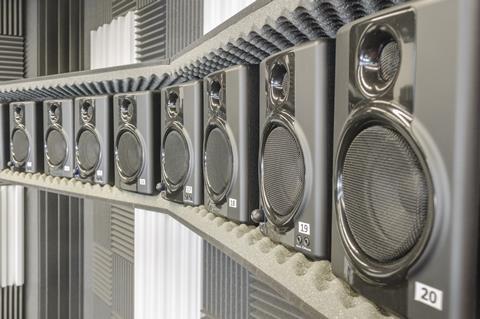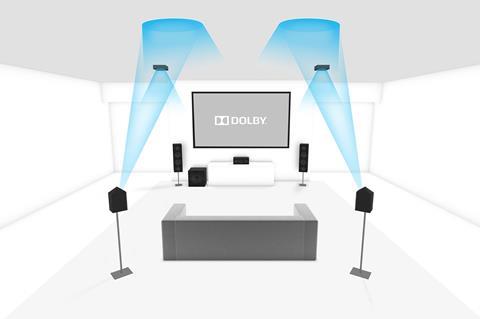Advances in technology and new media devices are bringing premium features like immersive audio to a wider audience. Kevin Hilton looks at how market leader Dolby Atmos got to this point and the current state of the spatial sound market.

Surround sound is as much about being immersed in the audio experience as it is quality. Despite this it became the preserve of enthusiasts and tech heads during the home entertainment cinema boom of the 1990s. The aim was to recreate in your front room the cinema experience of enveloping audio that came as close as it could to the way people perceive sound in the real world, with a sense of length, width and depth.
The first commercially successful system to offer this was Dolby Stereo Surround, a matrixed technology with rear channels encoded into the front left, centre, right main signal. Dolby made its name with noise reduction technologies for cassette recorders; it later moved into films through this processing technique. The breakthrough into surround came with Ken Russell’s 1975 extravaganza Lisztomania, which had a Dolby A optical soundtrack plus additional channels for satellite loudspeakers. It was, however, Star Wars (Episode IV: A New Hope) in 1977 that showed what Dolby Stereo could do and gave audiences a taste for something more than just conventional stereo.
During the 80s Dolby Stereo Surround became both a creative element in filmmaking and a useful selling point. It crossed over into home video, where it was known as Dolby Pro Logic. There was even some take-up in radio; producer Dirk Maggs produced several series in DPL for BBC Radio 1 based on the adventures of Superman, Spider-man and Batman. Into the 90s some broadcasters and production companies, notably Granada, mixed shows such as Cracker and Prime Suspect in Dolby Surround, following the lead of US imports such as ER, The X-Files and The Simpsons.
Despite programmes being post-produced in surround, many broadcasters - primarily the BBC and Channel 4 - did not actively promote this feature. But they also did not strip any surround soundtracks from the shows, meaning viewers with the right equipment could enjoy the benefits. A big change in the 90s was the introduction of discrete digital surround. This did away with the matrix and offered five independent channels (front left, centre, front right, rear left, rear right, plus a sub bass, making a total of 5.1 channels). Again Dolby was a leader in this, producing Dolby Digital 5.1, which first appeared on Batman Returns in 1992.
This time Dolby had direct competition. DTS (Digital Theatre Systems) introduced its 5.1 discrete digital surround system in 1993 on Jurassic Park. The film business readily took to 5.1, which also made some inroads into TV, the sell-through market (both DVD and later Blu-ray Disc), gaming and the mobile device market. Today a great many high-end TV dramas are mixed in 5.1, with sound design very much in the cinema style.
The channel counts for both Dolby Digital and DTS Digital Surround were expanded to 7.1 but this still did not provide the height element necessary to produce a full sound picture. A number of projects were underway in the early 2000s to develop a more immersive audio system to complement 4k and 8k TV. At the same time Dolby and Belgian developer Auro Technologies were looking into spatial formats for cinema.

Dolby introduced its contender, Atmos, on the release of the Disney Pixar animation Brave in 2012. Atmos is based on 7.1 channels but also uses object-based audio (OBA) to create the sense of height and movement. Auro Technologies initially stuck with the channel approach, producing the 11.1 Auro 3D system, but has since introduced its own OBA-based offering, AuroMax. DTS (now owned by Xperi) is still in the fray with another OBA system, DTS:X.
Taking the lead
Atmos is the market leader, with 4,800 Atmos equipped screens internationally and over 1300 titles mixed and mastered in the format (as of the middle of this year). It is also available on Blu-ray and, along with MPEG-H 3D Audio, is part of the specification for Ultra High Definition Next Generation Audio, together with other options in the Dolby AC-4 format.
“As the number of Dolby Atmos devices increases, we have also seen the amount of content for these devices continue to grow - we now have over ten partners streaming Dolby Atmos content [with a combined availability of] over 1,200 pieces.” Kevin Yeaman, Dolby
Netflix, iTunes and Amazon Prime Video streaming services have made Dolby Atmos a big part of their marketing and offering, as have BT Sport and Sky. Most linear broadcasters, however, have not as yet made a decision and continue with 5.1 and stereo. The take-up and enthusiasm for immersive audio in general has been encouraged by the appearance of soundbars and all-in-units such as Sky’s Soundbox, which get round the problems of a big outlay and needing a large number of loudspeakers in the front room.
- Read more: Netflix rolls out ‘studio quality’ audio
Soundbars and other equipment are now dropping in price but smartphones and the mobile market in general are proving to be a great leveller. Suitably equipped handsets and headphones are enabling people to get immersive audio - Dolby Atmos in particular - wherever they may be.
This point was made by Dolby’s chief executive and president Kevin Yeaman at the beginning of August during an earnings call webcast announcing the company’s third quarter results. “We continued to see Dolby Atmos experiences becoming increasingly available to more people around the world,” he said, citing Apple’s announcement that it will add the audio format to its iPhone 10, iPhone 8 and iPad Pro later this year.
To support this Apple iTunes has 300 titles available in Dolby Atmos, including A Star is Born, Bohemian Rhapsody, Bumblebee, Fantastic Beasts: The Crimes of Grindelwald and The Lego Movie 2. The other two in the top three of mobile manufacturers, Samsung and Huawei, have also incorporated Dolby Atmos technology into their most recent phones, while it features in Lenovo and Dell PCs and four out of five leading sound bars in the sub-$500 price bracket.
“We plan to focus on improvements to our audio offering as we look to provide customers with the ultimate sports experience on all platforms.” Jamie Hindhaugh, BT Sport
Of the two big hitters in streaming, Netflix now claims over 200 hours of Dolby Atmos material on original series such as Birdbox, Roma, and Stranger Things. The first Amazon original series to feature Atmos was Tom Clancy’s Jack Ryan, while other shows in the format are Westworld and Game of Thrones. “As the number of Dolby Atmos devices increases, we have also seen the amount of content for these devices continue to grow,” Yeaman commented. “We now have over ten partners streaming Dolby Atmos content [with a combined availability of] over 1,200 pieces.”
BT Sport has had an ongoing R&D relationship with Dolby for some time and broadcast its first Atmos programming in 2015. Since then the broadcaster has continued to produce coverage of live Premier League football games in Atmos. “We plan to focus on improvements to our audio offering as we look to provide customers with the ultimate sports experience on all platforms,” comments BT Sport chief operating officer Jamie Hindhaugh. He adds that this would involve greater personalisation of audio and a “stadium audio experience” on mobiles.
Commenting on the growth of Dolby Atmos over all platforms, not just film, Guy Hammett, an analyst at Futuresource Consulting, observed, “It was once a technology synonymous with premium luxury audio but is rapidly making its way into the mass market as Dolby pushes its immersive audio technology into a wide range of products. There is a clear opportunity for Dolby and while it cannot yet reach many consumers in developing market through home theatre systems, including Atmos in smartphones and other devices with high levels of ownership in these markets will increase recognition and demand for the technology.”
Interested in audio? Find out more in The new sound of Hollywood, in association with SMPTE Tech Talk session at IBC2019.
-
IBC2019 takes place 13-17 September at the RAI, Amsterdam
























No comments yet